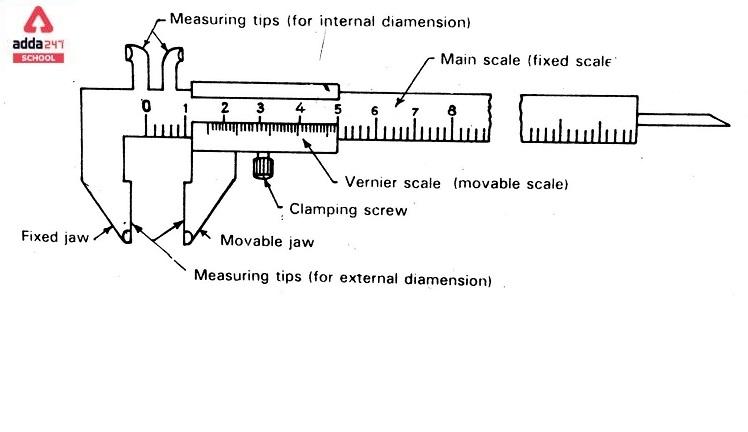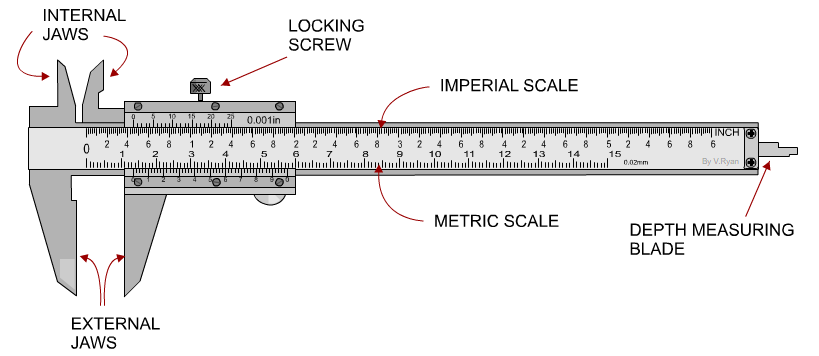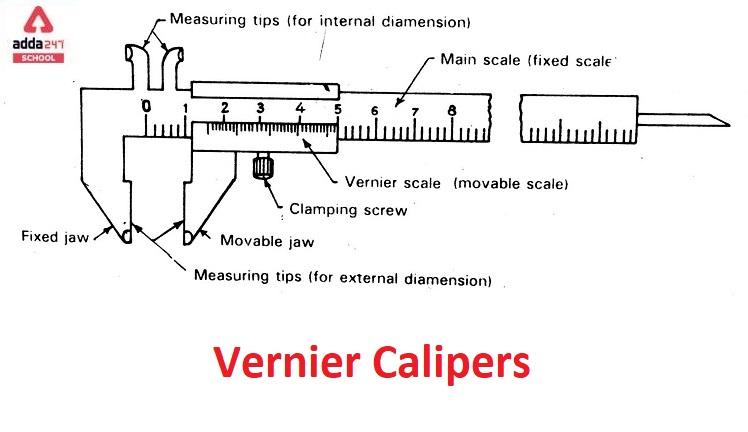Vernier Caliper
A vernier calliper is a device that measures the size of an object. A vernier calliper is a tool used in many industries, including mechanical engineering, metalworking, forestry, woodworking, science, and medicine. The British spelling for the same term is calliper.
A vernier calliper may read a measurement on a ruled scale, dial, or digital display, but other callipers are as simple as a compass with inward or outward-facing points but no scale. The points of the vernier calliper are adjusted to fit across the measurement places, and the dimension is calculated by measuring between the tips using another measuring tool. Another tool for measuring is a ruler.
Vernier Caliper Digital
In a common modification, an electronic display replaces the analogue dial in Digital Vernier Caliper. The reading is displayed on the display as a numeric value, and instead of a rack and pinion, these callipers use a linear encoder. Most digital vernier callipers allow you to convert between centimetres, millimetres, and inches, as well as zero the display at any place while the slide is in motion.
Furthermore, digital verniers can do the same differential measurements as dial callipers, but digital vernier callipers may include a “reading hold” feature. Furthermore, the dimensions of digital callipers can be read after use in difficult situations where the display is not visible.
Vernier Caliper Diagram
Here Vernier Caliper Diagram is given below.

Vernier Caliper Scale
- A single instrument is referred to as a “calliper” or “callipers,” while a vernier caliper is referred to as a “pair of verniers” or simply “vernier” in colloquial language.
- The oldest calliper was discovered in the Greek Giglio wreck off the coast of Italy, which goes back to the 6th century BC. The wooden component already had a fixed and movable jaw, and callipers were still in use by the Greeks and Romans, despite their rarity.
- During the Chinese Xin dynasty, a bronze calliper was used for minute measures, and an inscription on one indicated that it was manufactured on the first day of the first month of the first year of Shijianguo.
- Furthermore, Pierre Vernier devised the current vernier caliper as an improvement on Pedro Nunes’ nonius.
Vernier Constant
The vernier constant is also known as the least count of vernier calipers. The difference between one main scale division and one vernier scale division is defined.
It is denoted technically as VC = 1 MSD – 1 VSD.
When there are n divisions on the vernier scale that correspond to (n-1) divisions on the main scale, the vernier caliper with the lowest count is:
![]()
As a result, the smallest vernier caliper count is 0.1 mm. Where,
VC denotes the vernier constant.
The main scale division is MSD.
VSD stands for vernier scale division.
The least count is LC.
Read More About:
- Layers Of Atmosphere In Order, Sequence, Diagram
- Ohm’s Law: Definition, Formula, Examples
- First Law Of Thermodynamics
- Freedom Fighters Of India
- Most Popular Festivals Of India List
Vernier Scale Stucture
Stainless steel is used in most 6-inch digital vernier calipers. For longer measurements, the accuracy of the same technique decreases.
- The digital interface greatly reduces the time it takes to make and record a series of measurements, and it also enhances the reliability of the recordings.
- Digital vernier calipers include a serial data output that allows them to be interfaced with a dedicated recorder or a personal computer. An appropriate device to convert the serial data output to conventional computer interfaces can be created or purchased, and measurements can be entered directly into a spreadsheet, a statistical process control tool, or similar software using such a converter.
- These printed circuit boards combine to generate two variable capacitors that are out of phase. The capacitance changes in a linear and repeating pattern as the slider moves, and the circuitry integrated into the slider counts the bars as it moves and performs a linear interpolation based on the magnitudes of the capacitors to determine the precise position of the slider.
- Inductive linear encoders are found in other digital calipers. Magnetic linear encoders are utilized in other digital calipers, while inductive linear encoders enable for reliable performance in the presence of contamination such as coolants.
- The Main Scale
It is a huge scale that runs the length of the vernier caliper’s body. Depending on the use, the main scale reading could be in centimetres or mm. - The Vernier ScaleThis is the smaller scale that is attached to the larger scale and moves along it. A metric calliper’s vernier scale can be divided into up to 50 increments, each measuring 0.02 mm. The movement of the vernier scale is determined by the opening of the jaws. The vernier scale’s primary role is to offer precision to the main scale reading by splitting it into smaller increments.
- Lower jawsThese jaws are one of the most noticeable aspects of a vernier caliper. One of the jaws is anchored to the main scale. The other jaw is moveable and connected to the vernier scale. The lower jaw’s primary role is to measure outside dimensions such as diameter, width, and length.
- Upper JawsThese jaws are comparable to the lower jaws, except they are smaller. These jaws are coupled to the vernier scale’s upper portion. One jaw is stationary, while the other is moveable. The upper jaw’s primary purpose is to measure the inside dimensions of objects.
- The Depth RodThe depth rod can be used to measure the levels of the jars. It is a slender rod at the bottom of the main scale. It is simple to measure with a depth rod. The main scale’s edge is put on the object’s top surface. The jaws are then progressively opened. The opening of the jaws causes the depth rod to extend. The jaws must be opened till the depth rod touches the object’s bottom.
- The Thumb ScrewThis screw is at the very bottom of the vernier scale. The thumbscrew’s primary function is to provide users with a grip so that the jaw does not slide. Upper jaws can be used to measure the internal diameters of objects such as hollow pipes and jars.
- Locking ScrewThe lock screw’s primary function is to secure the setting of the jaws once the object is securely held between the jaws. This also makes taking accurate readings easier.
Vernier Caliper drawing Image
Vernier Caliper Drawing Images are given below.

Vernier Caliper Scale Reading and Measurement
A vernier caliper is made up of two scales, one of which is fixed and the other of which is adjustable. The main scale, also known as the fixed scale, is a calibrated L-shape frame with a fixed jaw. The Vernier scale, a movable scale that slides over the main scale and has a moveable jaw to measure tips for internal and external measurements, glides over the main scale.
The vernier caliper scale is used for both internal and external measurements when the measurement falls between two of the graduations on the main scale. vernier caliper works by clamping the jaws down on the work surface and readings from the main scale. An adjustment screw is supplied to lock the sliding scale on the fixed scale for the exact placement of the movable jaw.
How to take reading using a Vernier Caliper?
The procedure for reading a Vernier caliper is explained in detail below.
- The first step is to measure nothing in order to determine whether the main and vernier scales are aligned.
- When both the main scale and the vernier scale readings are zero, there is no zero error.
- Place a ball between the vernier scale’s two jaws.
- Examine the 0 mark on the vernier scale that lines up with the main scale.
- This results in the primary scale reading.
- Next, locate the position on the vernier scale that is parallel to the main scale and provides the vernier scale reading.
- It is vital to note that most of the time, the readings will be in decimals.
- The number preceding the decimal point represents the main scale reading, while the number after the decimal point represents the vernier scale reading.
Vernier Caliper Uses
To measure the distance between two objects, Vernier calipers are utilized. They are used to determine the size of an object. The vernier caliper’s primary function is to measure the distance between objects as well as their interior and external dimensions, including height. A vernier caliper has a resolution of up to a tenth of a millimeter. Vernier calipers are used in the following industries.
- Education sector – utilized to measure temperature-changing materials as well as regular and irregular items.
- Medical uses – utilized to measure surgical and medical tools.
- scientific labs – utilized to measure equipment in scientific labs to ensure error-free experiments.
- The steel industry is used to measure the length, width, and height of items in order to produce consistent goods of the same size.
- Aerospace industry – utilized to measure even minute features in aerial parts to avoid air accidents.
Related Post:
- Radius Of Earth
- Modern Periodic Table Of Elements With Name & Atomic Mass
- Barriers Of Communication: Definition, Examples, Download PDF
- Difference Between Plant Cell And Animal Cell
- Difference Between Mass And Weight









 CUET UG Final Answer Key 2025 Revised, D...
CUET UG Final Answer Key 2025 Revised, D...
 DU Cut off 2025, Delhi University Expect...
DU Cut off 2025, Delhi University Expect...
 OUAT Result 2025 OUT @ouat.nic.in: Check...
OUAT Result 2025 OUT @ouat.nic.in: Check...









